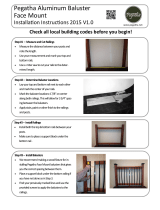Page is loading ...

verandadeck.com
Offset bracket 1/32 in. – 1/16 in. from the
end of the rail. Mark locations of the holes.
With the brackets secured to the rails,
place and glue (PVC adhesive) the supplied
crush blocks to the bottom of the bottom
rail between the posts to support the rail in
a level position.
VER-0065-PKG 2/14
Predrill using a 1/8 in. bit.
Completely lower the rail and mark bracket hole locations. Remove the rail before pre-drilling
the holes.
Secure with supplied #10 x 1 in. screws.
DO NOT OVER TIGHTEN.
1
4
2
5
3
Rail Installation Instructions
Prior to installing railing:
Please consult local zoning laws in regards to load requirements and bottom space requirements for rails. All supporting
structures must be in accordance with applicable building codes. Neighborhood associations and/or historic districts may
regulate size, type, placement and ability of railing. Apply for permits if required by local authorities and codes. Ensure
compliance prior to installation. Local building code requirements will always supersede any and all suggested procedures and
measurements in the following installation. The following installation instructions are intended as a general guideline based on
common building practices used in railing installation.
If using cove molding, slide cove molding down over post prior to securing any railings. Measure the distance between properly
installed, plumb posts. Transfer the measurement to the top rail, making sure that the distance from the end of the rail to the
rst baluster slot is equal on both ends of the rail. (NOTE: The minimum distance from post to rst baluster slot is 2 -1/8 in. for
clearance from the brackets.) Place the rails together so that the top and bottom baluster slots are aligned. Mark the bottom rail
for the inside distance between the posts. Cut the top and bottom rails to t tightly between the posts.

verandadeck.com
Pre-drill the holes with a 1/8 in. bit, angling
slightly upward and inward to allow for
clearance from the rail once repositioned
for securing. NOTE: using extended drill
bits is recommended to prevent damage
to the rail, and allow a more perpendicular
driving angle.
Mark the location of the bracket holes.
After marking hole locations, remove top
rail and balusters. Pre-drill the holes with
a 1/8 in. bit, angling slightly upward and
inward to allow for clearance from the rail
once repositioned for securing. DO NOT
OVERTIGHTEN. Bracket shown for visual
reference only.
Secure the top bracket allowing 1/32 in.
– 1/16 in. from the end of the rail. Mark
locations of the holes and predrill using a
1/8 in. bit. Secure with supplied #10 x 1 in.
screws. DO NOT OVER TIGHTEN.
Insert all balusters into the bottom rail.
Reposition the top rail over the balusters,
and lower into place between the posts.
After the top rail is fully inserted, secure
using the supplied #10 x 2 in. screws. NOTE:
using extended drill bits is recommended
to prevent damage to the rail, and allow a
more perpendicular driving angle. DO NOT
OVERTIGHTEN.
6
10
11
7
12
Insert a baluster into the rst and last
baluster holes.
Carefully position the top rail between the
posts and lower onto the two balusters,
making sure to fully seat the balusters into
the top rail.
8
9
13
14
Complete the installation by gluing the
post cap in place using a quality exterior
adhesive.

verandadeck.com
Perfore previamente los hoyos con una
broca de 3.2 mm, inclinando ligeramente
hacia arriba y hacia adentro para dejar
un espacio con respecto al travesaño
una vez que este se haya reposicionado
para jarlo. NOTA: se recomienda utilizar
brocas extendidas para evitar dañar
el travesaño y permitir un ángulo de
arrastre más perpendicular.
Fije el soporte superior dejando una
distancia de 0.8 mm a 1.6 mm desde
el extremo del travesaño. Marque la
ubicación de los hoyos y realice las
perforaciones previas con una broca
de 3.2 mm. Fije con los tornillos N°. 10
de 2.5 cm suministrados. NO APRIETE
EN EXCESO.
6 7
Introduzca un balaústre en el primero
y en el último hoyo del balaustre.
8
Marque la posición de los hoyos donde
van los soportes.
Coloque con cuidado el travesaño superior
entre los postes y bájelo sobre los dos
balaústres.
Perfore previamente los hoyos con una
broca de 3.2 mm, inclinando ligeramente
hacia arriba y hacia adentro para dejar
un espacio con respecto al travesaño una
vez que este se haya reposicionado para
jarlo. NO APRIETE EN EXCESO.
Inserte los balaústres restantes en el
travesaño inferior. Vuelva a colocar el
travesaño superior sobre los balaustres y
bájelo hasta su posición entre los postes.
Tras haber insertado completamente el
travesaño superior, fíjelo con los tornillos
N°. 10 de 5 cm suministrados. NOTA: se
recomienda utilizar brocas extendidas
para evitar dañar el travesaño y permitir
un ángulo de arrastre más perpendicular.
NO APRIETE EN EXCESO.
Termine la instalación pegando las tapas
de los postes en el lugar adecuado,
utilizando un adhesivo de calidad
para exteriores.
10
11
9
12
13
14
/

















